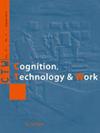老龄男女种植户之间工作条件和健康问题的比较。
IF 3.4
3区 工程技术
Q2 ENGINEERING, INDUSTRIAL
引用次数: 2
摘要
虽然韩国农民的数量在减少,但年龄≥60岁的老年农民的比例在增加。目的分析60岁以上高龄种植户在劳动条件、危险因素暴露和健康问题方面的性别差异。方法本研究使用第五次韩国劳动条件调查(KWCS)数据,调查对象为年龄≥60岁的作物农民,男性818人,女性985人。结果老年女性农民独居率(45.0%比13.4%,p < 0.001)、受教育程度(80.7%比53.4%,p < 0.001)、平均收入(1565比203.6万韩元,p < 0.001)均低于男性。在危险因素暴露的主观得分中,只有女性的重复动作(4.923分)和尴尬姿势(4.415分)高于男性的重复动作(4.601分)(p < 0.001)和尴尬姿势(4.159分)(p = 0.001)。女性上肢疼痛(68.3%)、下肢疼痛(67.6%)、背痛(48.4%)、整体疲劳(44.8%)、头痛和眼疲劳(25.0%)的健康问题主诉率高于男性上肢疼痛(48.5%)(p < 0.001)、下肢疼痛(53.3%)(p < 0.001)、背痛(35.0%)(p < 0.001)、整体疲劳(39.5%)(p = 0.024)、头痛和眼疲劳(19.4%)(p = 0.005)。女性抑郁症状发生率(54.6%)高于男性(46.9%),且单身家庭比例较高(p = 0.001)。结论老年农妇骨骼肌疼痛和抑郁症状普遍存在,需要努力改善劳动条件。本文章由计算机程序翻译,如有差异,请以英文原文为准。
Comparisons of working conditions and health-related problems between older male and female crop farmers.
BACKGROUND
Although the number of farmers in Korea is declining, the proportion of older farmers aged ≥60 increases.
OBJECTIVE
This study aims to analyze gender differences in working conditions, exposure to risk factors, and health problems of older crop farmers aged ≥60.
METHODS
This study used data from the 5th Korean Working Conditions Survey (KWCS) data of 818 male and 985 female crop farmers aged ≥60 years.
RESULTS
This study showed that older female farmers had higher ratios of living alone (45.0% vs. 13.4%, p < 0.001), lower education levels (80.7% vs. 53.4%, p < 0.001), and lower average incomes (1.565 vs. 2.036 million KRW, p < 0.001) than that of males. Among subjective scores on the exposure of risk factors, only females' repetitive motion (4.923) and awkward posture (4.415) scores were higher than that of males' repetitive motion (4.601) (p < 0.001) and awkward posture (4.159) scores (p = 0.001). However, female's health problem rates on upper limb pain (68.3%), lower extremity pain (67.6%), backache (48.4%), overall fatigue (44.8%), and headache and eyestrain (25.0%) were higher than that of male's complaint rates on upper limb pain (48.5%) (p < 0.001), lower extremity pain (53.3%) (p < 0.001), backache (35.0%) (p < 0.001), overall fatigue (39.5%) (p = 0.024), and headache and eyestrain (19.4%) (p = 0.005). The rate of depression symptoms in females (54.6%), with a high proportion of single-person households, was higher than that of males (46.9%) (p = 0.001).
CONCLUSIONS
The musculoskeletal pains and depression symptoms of older female farmers are prevalent, and efforts and support are required to improve working conditions.
求助全文
通过发布文献求助,成功后即可免费获取论文全文。
去求助
来源期刊

Cognition Technology & Work
ENGINEERING, INDUSTRIAL-
CiteScore
6.90
自引率
7.70%
发文量
26
审稿时长
>12 weeks
期刊介绍:
Cognition, Technology & Work focuses on the practical issues of human interaction with technology within the context of work and, in particular, how human cognition affects, and is affected by, work and working conditions.
The aim is to publish research that normally resides on the borderline between people, technology, and organisations. Including how people use information technology, how experience and expertise develop through work, and how incidents and accidents are due to the interaction between individual, technical and organisational factors.
The target is thus the study of people at work from a cognitive systems engineering and socio-technical systems perspective.
The most relevant working contexts of interest to CTW are those where the impact of modern technologies on people at work is particularly important for the users involved as well as for the effects on the environment and plants. Modern society has come to depend on the safe and efficient functioning of a multitude of technological systems as diverse as industrial production, transportation, communication, supply of energy, information and materials, health and finance.
 求助内容:
求助内容: 应助结果提醒方式:
应助结果提醒方式:


